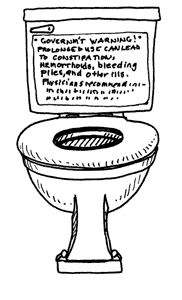STRANGE BUT TRUE- Squatters: The best way to poop

DRAWING BY DEBORAH DERR McCLINTOCK
Q. What are the wages of toilet-sitting? Wouldn't we all do better just to squat, as is done in many cultures? M. Whipple
A. A toilet has the sitter leaning somewhat forward, often with weight resting on the thighs, says Adam Hart-Davis in Thunder, Flush and Thomas Crapper. This creates a sharp angle, almost a kink, between the rectum and anus.
"Feces have to change direction, and the more they're pushed, the worse the angle gets," Hart-Davis says. Squatting shifts the rectum nearly vertical, in straight line with the anus, so muscles work together better, aided by gravity.
"Toilet sitters by comparison suffer more constipation– leading cause of visits to gastroenterologists– plus hemorrhoids, bleeding piles and other ills," says Dr. Douglas A. Corley at the University of California, San Francisco.
Still, you won't hear many docs prescribe giving the old throne the boot.
Q. When a psychological experimenter shocks a laboratory rat, what is the animal apt to do to a second rat in the cage? This actually is a "hot" question. –Mrs. Frisby
A. Researchers were trying to test whether stopping foot shocks would reinforce positive feelings between the rats, says David G. Myers in Social Psychology. But this experiment proved impossible because as soon as the shocks began, the rats attacked one another, before the experimenter could turn off the juice.
The test was then replicated with cats, foxes, turtles and snakes. And guess who else? In tests of "aversive stimuli" such as heat, people have shown themselves to be distinctly rat-like.
For example, in North America and Western Europe, violent crimes are more likely on hotter days. This also holds for hotter years, hotter cities, and hotter regions. "Assuming predicted global warming occurs, by 2050, the U.S. alone will see 115,000 more serious assaults annually," says Myers
Other data: The riots of the 1960s occurred during "the long hot summers." In hot cities like Phoenix, drivers without air-conditioning honk more readily at stalled cars. And baseball pitchers hit two-thirds more batters during games when temps hit the 90s compared with below 80F.
"Pitchers weren't wilder on hot days– they had no more walks and wild pitches. They just clobbered more batters," says Myers.
Hotter question: How to keep those tempers cool?
Q. Can dreams serve as early warning signs of illness? –J. Hong
A. The notion is ancient, embraced by Aristotle and Hippocrates, father of Greek medicine, says Charlottesville resident Robert L. VandeCastle in Our Dreaming Mind. Second-century Greek physician Galen told of a man who dreamed his leg turned to stone, then days later suffered paralysis.
Best-selling author Dr. Bernard Siegel described a journalist's dream where torturers placed hot coals under the dreamer's chin. Later, doctors pooh-poohed the man's fear of cancer, until tests confirmed cancer of the thyroid.
"Dreams can be like X-rays in some cases," says VandeCastle. One woman dreamed repeatedly her leg was being examined by a nurse who would hold the candle closer and closer until it started to burn the shin. Soon after the dream series, the woman was diagnosed with a bone infection."
In Forewarning Cancer Dreams and the Bioplasma Concept, neurologist Daniel Schneider recounts the case of a heavy smoker who dreamed he was in an army combat zone trying to take cover in the hollow of a tree, but enemy fire cut him in half across the chest. A checkup revealed a small lung tumor that had not yet metastasized.
A depressed patient of Schneider's dreamed he was onstage, opened a violin case, and pulled out a machine gun and shot himself. As the rat-a-tat-tat of the gun raged, he awoke, only to suffer a heart attack minutes later. The loud, rhythmic rat-a-tat-tat heard in his dream was likely his own heart racing.
This is a fertile area for more research, says VandeCastle. "Many dreams seem to have a warning function, and may be useful or adaptive if heeded."
Q. "Quick, estimate the answer to 8 x 7 x 6 x 5 x 4 x 3 x 2 x 1." Ask this of several friends, then have others estimate 1 x 2 x 3 x 4 x 5 x 6 x 7 x 8. How did you just prove "It's important to make a good first impression"? –L. Cohen
A. When something like this was tried, the average guess for the descending series was 2,250, but only 512 the other way, says Spencer Rathus in Essentials of Psychology. Obviously, both yield the same answer: 40,320.
Apparently, people seeing "8" in the initial position psychologically anchored on the higher numbers, pushing their estimates up. The opposite occurred with the reverse sequence. Once formed, estimators' first impressions of the series prevailed, in spite of the subsequent numbers.
Moral: Put your best foot (high numbers) forward.
Send Strange questions to brothers Bill and Rich at
#